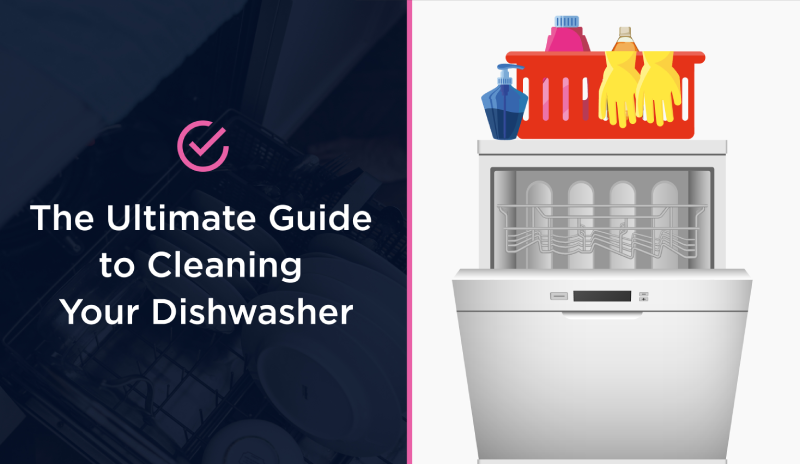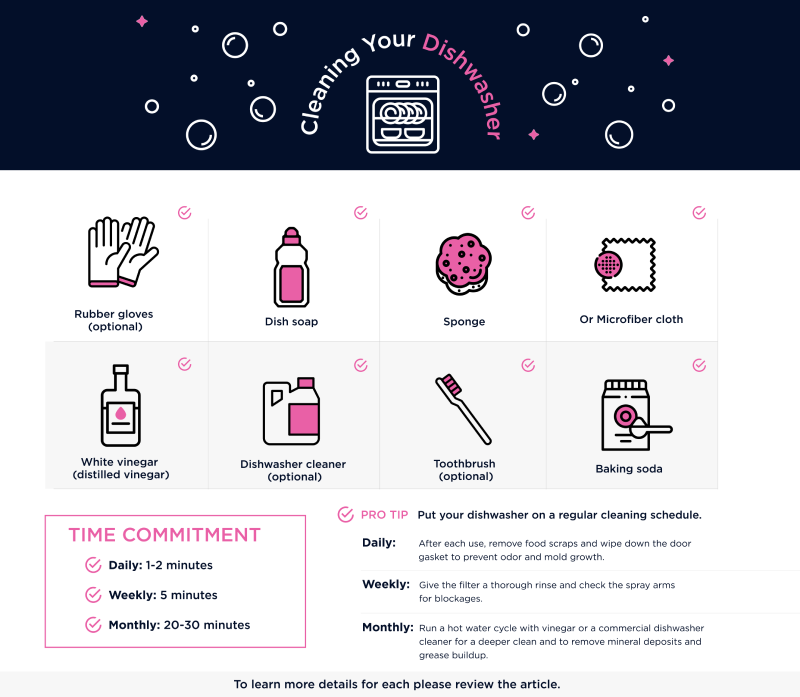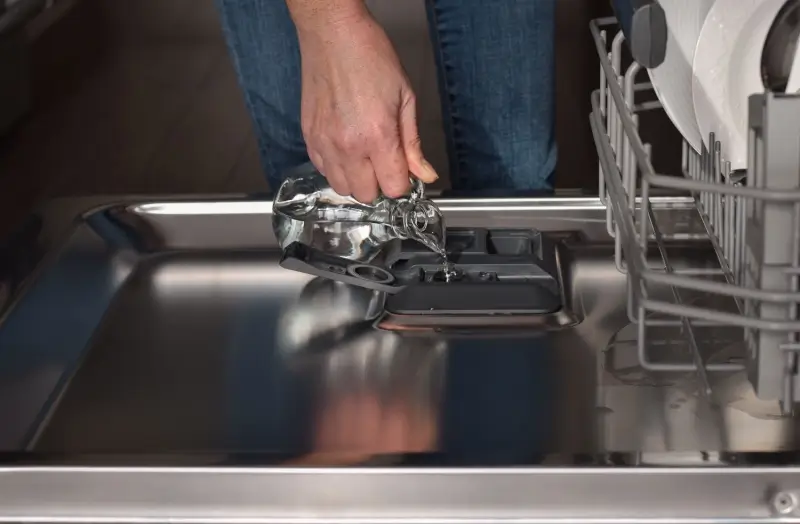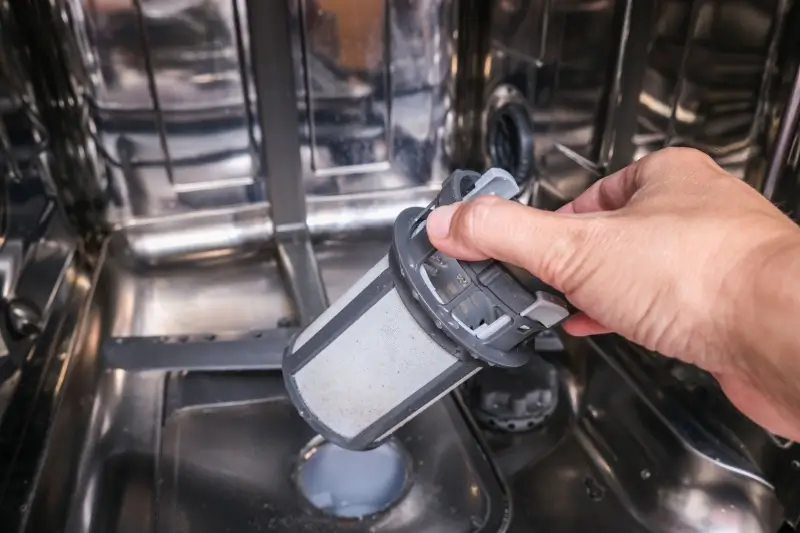
Keeping your dishwasher clean isn't just about sparkling dishes; it's about maintaining an efficient and hygienic appliance essential for your kitchen. This comprehensive guide will be your one-stop shop for all things dishwasher maintenance.
We'll break down the process into easy-to-follow steps, complete with product recommendations to tackle every cleaning task. We've also incorporated expert advice, inspiring success stories from real users, and solutions to common dishwasher cleaning problems you might encounter.
And to leave no question unanswered, we'll wrap it up with a handy FAQ section. So, let's get started and ensure your dishwasher runs smoothly and delivers sparkling clean dishes!
Table of Contents:
- Understanding Your Dishwasher's Needs
- Step-by-Step Dishwasher Cleaning Guides
- Daily Maintenance Tips
- Weekly Cleaning Steps
- Monthly Thorough Clean Procedures
- Vinegar Technique
- Cleaning Individual Parts
- Exterior Cleaning
- Troubleshooting & Solving Your Dishwasher Problems
- When to Call a Professional
- Dishwasher Cleaning FAQ
Understanding Your Dishwasher's Needs
Just like any other hardworking appliance, your dishwasher thrives on regular cleaning.
The Importance of Regular Cleaning:
- Longevity: Food residue, mineral buildup, and soap scum can clog essential components like the filter and spray arms. Regular cleaning prevents these issues, extending your dishwasher's lifespan and saving you money on repairs or replacements down the road.
- Effectiveness: A clean dishwasher works harder, not smarter. When grime isn't hindering performance, your dishwasher can use water and energy more efficiently, ensuring sparkling clean dishes every cycle.
- Hygiene: A clean dishwasher means a healthier kitchen. Food particles trapped inside can harbor bacteria and mold growth. Regular cleaning promotes a hygienic environment for your dishes.
Dishwasher Touchpoints Needing Extra Attention:
- Filter: A clogged filter reduces water flow and cleaning power.
- Spray Arms: Food particles and mineral buildup can impact their cleaning performance.
- Door Seals: Over time, food debris and grime accumulate, potentially leading to seal leaks and odors.
Step-by-Step Dishwasher Cleaning Guides

Keeping your dishwasher clean doesn't have to be a chore. Here's a breakdown of how often to tackle different cleaning tasks, along with the supplies you'll need:
Supplies:
- Rubber gloves (optional)
- Dish soap
- Sponge or microfiber cloth
- Baking soda
- White vinegar (distilled vinegar)
- Dishwasher cleaner (optional)
- Toothbrush (optional)
Time Commitment:
- Daily: 1-2 minutes
- Weekly: 5 minutes
- Monthly: 20-30 minutes
a. Daily Maintenance Tips (1-2 minutes)
These quick habits will keep your dishwasher functioning optimally on a daily basis:
- Scrape Dishes: Before loading your dishwasher, take a minute to scrape any leftover food scraps or debris into the trash. You don't need to rinse dishes beforehand, as modern dishwashers and detergents are designed to handle light food residue.
- Wipe Down the Door Gasket: Before you start your dishwashing cycle, give the door gasket a quick wipe with a damp cloth to remove any food particles that might cause odors or mold growth.
b. Weekly Cleaning Steps (5 minutes)
Keeping up weekly will go a long way in allowing your appliance to perform at its best.
- Clean the Filter: Consult your dishwasher's manual for specific instructions on removing the filter. Rinse it thoroughly under running water to remove any trapped food particles.
- Check Spray Arms: Occasionally, food particles can get lodged in the spray arm holes. Rotate the spray arms by hand and inspect for clogs. You can use a toothpick to carefully clear any blockages.
- Wipe Down the Door and Control Panel: Use a damp microfiber cloth with a few drops of dish soap to wipe down the exterior door and control panel. This keeps your dishwasher looking clean and prevents grime buildup.
c. Monthly Thorough Clean Procedures (20-30 minutes)
Once a month, give your dishwasher a thorough clean to remove built-up grime and odors. Take a two-part approach using natural solutions or commercial cleaners:
Method 1: Natural Cleaning with Vinegar and Baking Soda
- Empty Dishwasher: Remove any dishes from the dishwasher.
- Vinegar Rinse: Pour 2 cups of white vinegar into a dishwasher-safe container and place it on the top rack. Run a hot water cycle without heat drying. The vinegar will help break down mineral deposits and deodorize the dishwasher.
- Baking Soda Freshener: After the vinegar cycle, sprinkle 1 cup of baking soda across the dishwasher bottom. Run a short hot water cycle (without heat drying) to help remove any remaining residue and freshen the interior.
Method 2: Commercial Dishwasher Cleaner
- Follow Product Instructions: Choose a reputable dishwasher cleaner and follow the manufacturer's instructions for dosage and placement within the dishwasher.
- Run Hot Water Cycle: Most instructions will include running a hot water cycle with the dishwasher cleaner to remove built-up grease and grime.
Tip: For stubborn grime in the spray arms or around the door seal, you can use a toothbrush dipped in the vinegar or baking soda solution and scrub gently.
Vinegar Technique

Vinegar is a natural powerhouse for cleaning your dishwasher. It's safe, readily available, and effective at tackling several cleaning challenges:
- Dissolves Mineral Deposits: Hard water can leave mineral deposits that clog spray arms and reduce cleaning performance. Vinegar's acidity helps dissolve these deposits, keeping your dishwasher functioning optimally.
- Cuts Through Grease: Food grease can build up inside the dishwasher, leading to odors and decreased cleaning effectiveness. Vinegar's natural grease-cutting properties can help remove greasy residue.
- Deodorizes: Lingering food smells can be a common dishwasher woe. Vinegar's mild acidity neutralizes odors, leaving your dishwasher smelling fresh and clean.
To clean your dishwasher with vinegar, gather supplies and follow three simple steps:
Supplies:
- 2 cups white vinegar (distilled)
- Dishwasher-safe mug or bowl
- Baking soda (optional)
Steps:
- Empty the Dishwasher: Remove any dishes from the dishwasher.
- Place Vinegar: Pour 2 cups of white vinegar into a dishwasher-safe mug or bowl. Place it upright on the top rack of the dishwasher.
- Run Hot Water Cycle: Run a hot water cycle without the heat drying option. The hot water and vinegar combination will work together to loosen grime and deodorize the dishwasher interior.
Vinegar and Baking Soda for Extra Cleaning Power:
Want to boost your cleaning power? Combine vinegar with baking soda for an even more effective clean:
- Vinegar Rinse: Follow steps 1 to 3 from the vinegar cleaning method above.
- Baking Soda Freshener: After the vinegar cycle is complete, sprinkle 1 cup of baking soda on the bottom of the dishwasher.
- Short Hot Water Cycle: Run a short hot water cycle without heat drying to remove any remaining residue and leave your dishwasher smelling fresh with the deodorizing power of baking soda.
Why Vinegar and Baking Soda Make a Clean Combo:
- Natural and Safe: Both vinegar and baking soda are natural cleaning agents, making them a safe choice for those who prefer to avoid harsh chemicals.
- Cost-Effective: Vinegar and baking soda are readily available and inexpensive, making this a budget-friendly cleaning solution.
- Effective Cleaning: This combination tackles mineral deposits, grease, and odors, leaving your dishwasher clean and fresh.
However, there are a few things to consider:
- For Heavily Soiled Dishwashers: For heavily soiled dishwashers with significant grease buildup, a commercial dishwasher cleaner might be more effective for the initial clean.
- Not for All Dishwashers: Consult your dishwasher's manual before using vinegar, as some manufacturers advise against it for certain models.
Cleaning Individual Parts
While regular maintenance keeps your dishwasher functioning smoothly, individual parts might require occasional focused cleaning.
The Filter:

- Consult Your Manual: Every dishwasher model has a slightly different filter removal process. Refer to your dishwasher's manual for specific instructions on locating and removing the filter.
- Remove the Filter: Locate the filter at the bottom of the dishwasher tub, typically near the spray arms. Most filters lift out or twist to detach.
- Rinse Thoroughly: Hold the filter under running water and rinse away any trapped food scraps or debris. You can use a soft brush to gently remove stubborn grime.
- Clean the Filter Housing: If you notice food particles around the filter housing in the dishwasher tub, you can wipe it down with a damp cloth or a toothbrush dipped in vinegar solution.
- Reinstall the Filter: Once clean and rinsed, put the filter back in its designated place, ensuring it's securely locked in position (refer to your manual for proper placement).
The Drain:
While you shouldn't need to clean the drain itself frequently, you can check for clogs occasionally.
- Locate the Drain Access: Consult your dishwasher's manual to locate the drain access point. It might be a small panel at the bottom of the dishwasher or a screw-on cap.
- Remove Debris: Carefully unscrew the cap or remove the panel. Use a flashlight to peek inside and check for any large food scraps or debris that might be causing a clog. You can remove them by hand or with tongs.
Pro Tip: Line the floor with a rag or paper towels to quickly wipe up any mess.
- Hot Water Flush (Optional): Once you've removed any debris, pour a pot of hot (not boiling) water down the drain to clear any remaining clogs.
- Replace the Drain Access: Securely screw the cap back on or replace the access panel.
Utensil Holders and Racks:
Utensil holders and racks can accumulate food residue and grime over time. To keep them clean:
- Remove the Racks and Holders: Most dishwasher racks and utensil holders can be easily detached by pulling them out or flipping a latch.
- Soak in Hot, Soapy Water: For heavily soiled racks or holders, fill your sink with hot, soapy water and let them soak for 30 minutes to loosen grime.
- Scrub with Brush: Use a sponge or scrub brush to clean the racks and holders, paying attention to areas where food particles tend to accumulate.
- Baking Soda Paste: For stubborn grime, apply a 2:1 ratio (2 parts baking soda to 1 part water) paste to the soiled areas and let it sit for 15 minutes before scrubbing and rinsing.
- Rinse and Dry: Rinse the racks and holders thoroughly with clean water and let them air dry completely before placing them back in the dishwasher.
Door Gasket:
The door gasket can trap food particles and moisture, potentially leading to mold growth and odors.
- Wipe Regularly: Wipe down the door gasket with a damp cloth before running each dishwasher cycle to remove any food debris.
- Clean with Vinegar (Monthly): Once a month, dip a toothbrush in white vinegar and scrub the gasket to remove any built-up grime or mold. Use a cup or spray bottle to rinse the area with clean water and dry thoroughly with a paper towel.
Exterior Cleaning
A clean and shiny dishwasher exterior elevates the look of your kitchen. Following a few simple steps, allows your appliance to shine.
Supplies:
- Microfiber cloths (one damp, one dry)
- Dish soap
- Stainless steel cleaner
- All-purpose cleaner
Steps:
- Empty the Dishwasher: It's easier to clean the exterior with the dishwasher door open.
- Wipe with Damp Microfiber Cloth: For everyday cleaning, use a damp microfiber cloth to wipe down the entire exterior surface, including the door, control panel, and sides.
- Tackle Grime with Dish Soap: For stuck-on grime and fingerprints, add a few drops of dish soap to the damp microfiber cloth. Dish soap is a gentle cleanser that effectively removes everyday dirt and grease.
- Stainless Steel Appliances: If you have a stainless steel dishwasher, consider using a stainless steel cleaner specifically formulated for these surfaces. These cleaners leave a streak-free shine and protect the stainless steel finish. Apply the cleaner according to the manufacturer's instructions, typically a light application with a separate microfiber cloth.
- Stubborn Stains: For tougher stains or marks that don't respond to the above methods, you can use a mild all-purpose cleaner. Apply a small amount to the damp microfiber cloth and wipe gently on the affected area.
- Important Note: Always test any cleaning product on a small, inconspicuous area of the dishwasher exterior before applying it to the entire surface. This ensures the cleaner doesn't cause any discoloration or damage.
Additional Advice:
- Avoid abrasive cleaners, scouring pads, or harsh chemicals, as they can scratch the dishwasher's finish.
- Don't spray cleaning solutions directly onto the dishwasher. Apply the cleaner to the microfiber cloth first.
- For areas around the dishwasher door that trap crumbs or debris, use the vacuum cleaner with the hose attachment for a quick clean.
Troubleshooting & Solving Your Dishwasher Problems
Even the best-maintained dishwasher can encounter occasional issues. Most of them are quickly solved and you can troubleshoot them yourself before calling on the pros:
- Dishes Aren't Coming Out Clean: This can be caused by various factors, including clogged filters or spray arms, improper loading techniques, or inadequate detergent use. Follow the cleaning steps above.
- Water Doesn't Drain Properly: A clogged drain hose or disposal issue can prevent water from draining correctly, leaving your dishes sitting in dirty water. Consult your dishwasher manual on how to address a clogged hose.
- Strange Smells: Food particles trapped inside the dishwasher, along with hard water buildup or mold growth in the door gasket, can all contribute to unpleasant odors. To tackle your stinky dishwasher, follow the above steps.
- Leaking Dishwasher: A faulty door seal, loose hoses, or a clogged drain can all lead to leaks. Follow our cleaning tips on how to address grime on the door seal. Your dishwasher manual can help guide you in addressing a clogged drain. You may need to call on a pro to address worn or loose hoses.
- Unusual Noises: Grinding or knocking sounds during operation might indicate loose components or worn-out parts. We recommend you contact a trusted appliance repair service for repair or replacement assessment.
When to Call a Professional
While regular cleaning can tackle most dishwasher woes, there are situations where calling in a professional is the wisest course of action. Consider seeking expert help for:
- Complex Repairs: If your dishwasher is experiencing problems beyond clogged filters or minor leaks, such as malfunctioning control panels, electrical issues, or major water leaks, it's best to call a qualified appliance repair person.
- Stubborn Issues: If you've tried DIY troubleshooting methods for persistent problems like strange noises, persistent odors, or water not heating properly, and the issue remains unresolved, it's time to bring in a professional.
- Lack of Confidence or Expertise: If you're uncomfortable tackling certain cleaning tasks or unsure about diagnosing problems, don't hesitate to call a trusted appliance repair service. They have the knowledge and experience to handle the job efficiently and safely.
Molly Maid: Cleaning Help When You Need It
With a little know-how and some helpful cleaning partners, we hope this guide has inspired you to tackle everyday dishwasher maintenance. But sometimes life gets busy. Don't stress about cleaning your home – let the experts at Molly Maid take care of it for you!
Our skilled professionals offer a range of cleaning services, from one-time cleanings to weekly upkeep and special event cleaning. With our team of insured, licensed, and uniformed housekeepers, we're equipped to handle any cleaning challenge, backed by our Neighborly Done Right Promise® for your satisfaction.
For a complimentary house cleaning estimate in your area, reach out to your local Molly Maid branch today!
Dishwasher Cleaning FAQ
Keeping your dishwasher clean and efficient can be a breeze, but sometimes even the best of us have questions. Molly Maid's cleaning experts have a wealth of experience tackling cleaning challenges. We've answered countless questions from homeowners just like you, and we're happy to share that knowledge.
How often should you clean your dishwasher?
Put your dishwasher on a regular cleaning schedule.
- Daily: After each use, remove food scraps and wipe down the door gasket to prevent odor and mold growth.
- Weekly: Give the filter a thorough rinse and check the spray arms for blockages.
- Monthly: Run a hot water cycle with vinegar or a commercial dishwasher cleaner for a deeper clean and to remove mineral deposits and grease buildup.
What are the signs that my dishwasher needs cleaning?
The next time you open your dishwasher, and you encounter these clear signs, it’s time to get busy cleaning:
- Unpleasant odors
- Dishes not cleaning properly (cloudy film, food residue)
- Clogged filter or spray arms
- Leaking dishwasher
Can I use regular dish soap to clean my dishwasher?
No, regular dish soap isn’t recommended for your dishwasher. It can actually create excessive suds that can clog appliance components and leave a film on your dishes. Use vinegar, baking soda, or a commercial dishwasher cleaner specifically designed for this purpose.
How do I prevent odors from developing in my dishwasher?
Aside from not letting your dirty dishes sit too long in the dishwasher:
- Run the dishwasher with a hot water cycle and vinegar or baking soda monthly.
- Wipe down the door gasket after each use to remove any food debris.
- Don't overload the dishwasher, as this can prevent proper water circulation and lead to odor-causing bacteria growth.
